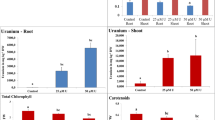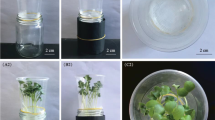Abstract
Uranium (U) phytotoxicity is an inherently difficult problem in the phytoremediation of U-contaminated environments. Plant chelating and antioxidant systems play an authoritative role in resistance to abiotic stress. To reveal the toxicity of U, the changes of chelating system, osmoregulatory substances and antioxidant systems in Vicia faba roots were studied after short-term (24 h) U exposure. The results indicated that the development of lateral roots and root activity of V. faba were significantly inhibited with U accumulation. Compared with the control, plant chelating systems showed significant positive effects after U exposure (15 − 25 μM). Osmoregulatory substances (proline and soluble protein) increasingly accumulated in roots with increasing U concentration, and O2− and H2O2 rapidly accumulated after U exposure (15 − 25 μM). Thus, the contents of malondialdehyde (MDA), a marker of lipid peroxidation, were also significantly increased. Antioxidant systems were activated after U exposure but were inhibited at higher U concentrations (15 − 25 μM). In summary, although the chelating, osmotic regulation and antioxidant systems in V. faba were activated after short-term U exposure, the antioxidases (CAT, SOD and POD) were inhibited at higher U concentrations (15 − 25 μM). Therefore, the root cells were severely damaged by peroxidation, which eventually resulted in inhibited activity and arrested root development.






Similar content being viewed by others
Data availability
The datasets used and/or analysed during the current study are available from the corresponding author on reasonable request.
References
Anke M, Seeber O, Müller R, Schäfer U, Zerull J (2009) Uranium transfer in the food chain from soil to plants, animals and man. Geochemistry 69:75–90
Asgher M, Per TS, Masood A, Fatma M, Freschi L, Corpas FJ, Khan NA (2017) Nitric oxide signaling and its crosstalk with other plant growth regulators in plant responses to abiotic stress. Environ Sci Pollut Res Int 24:2273–2285
Bates LS, Waldren RP, Teare ID (1973) Rapid determination of free proline for water-stress studies. Plant Soil 39:205–207
Baxter AMR, Suzuki N (2014) ROS as key players in plant stress signalling. J Exp Bot 65:1229–1240
Chen X, Wu G, Ma Q, Lai JL, Luo XG, Ji XH (2020) Cytotoxic and genotoxic evaluation and the toxicological mechanism of uranium in Vicia faba root. Environ Exp Bot 179:104227
Ernst WH, Krauss GJ, Verkleij JA, Wesenberg D (2008) Interaction of heavy metals with the sulphur metabolism in angiosperms from an ecological point of view. Plant Cell Environ 31:123–143
Farooq MA, Ali S, Hameed A, Ishaque W, Mahmood K, Iqbal Z (2013) Alleviation of cadmium toxicity by silicon is related to elevated photosynthesis, antioxidant enzymes; suppressed cadmium uptake and oxidative stress in cotton. Ecotoxicol Environ Saf 96:242–249
Gao N, Huang Z, Liu H, Hou J, Liu X (2019) Advances on the toxicity of uranium to different organisms. Chemosphere 237:124548
Gayatri G, Agurla S, Raghavendra AS (2013) Nitric oxide in guard cells as an important secondary messenger during stomatal closure. Front Plant Sci 4:425
Gechev TS, Van Breusegem F, Stone JM, Denev I, Laloi C (2006) Reactive oxygen species as signals that modulate plant stress responses and programmed cell death. BioEssays 28:1091–1101
Geng A, Wang X, Wu L, Wang F, Wu Z, Yang H, Chen Y, Wen D, Liu X (2018) Silicon improves growth and alleviates oxidative stress in rice seedlings (Oryza sativa L.) by strengthening antioxidant defense and enhancing protein metabolism under arsanilic acid exposure. Ecotoxicol Environ Saf 158:266–273
Gomes BR, Siqueira-Soares Rde C, Dos Santos WD, Marchiosi R, Soares AR, Ferrarese-Filho O (2014) The effects of dopamine on antioxidant enzymes activities and reactive oxygen species levels in soybean roots. Plant Signal Behav 9:e977704
Grill E, Winnacker EL, Zenk MH (1987) Phytochelatins, a class of heavy-metal-binding peptides from plants, are functionally analogous to metallothioneins. Proc Natl Acad Sci USA 84:439–443
Gupta DK, Vukovic A, Semenishchev VS, Inouhe M, Walther C (2020) Uranium accumulation and its phytotoxicity symptoms in Pisum sativum L. Environ Sci Pollut Res Int 27:3513–3522
Horemans N, Van Hees M, Van Hoeck A, Saenen E, De Meutter T, Nauts R, Blust R, Vandenhove H (2015) Uranium and cadmium provoke different oxidative stress responses in Lemna minor L. Plant Biol (Stuttg) 17(Suppl 1):91–100
Hossain MA, Bhattacharjee S, Armin SM, Qian P, Xin W, Li HY, Burritt DJ, Fujita M, Tran LS (2015) Hydrogen peroxide priming modulates abiotic oxidative stress tolerance: insights from ROS detoxification and scavenging. Front Plant Sci 6:420
Hu T, Zhang GX, Zheng FC (2018) Research progress in plant salt stress response. Mol Plant Breed 16:3006–3015
Islam F, Farooq MA, Gill RA, Wang J, Yang C, Ali B, Wang GX, Zhou W (2017) 2,4-D attenuates salinity-induced toxicity by mediating anatomical changes, antioxidant capacity and cation transporters in the roots of rice cultivars. Sci Rep 7:10443
Lai JL, Luo XG (2019) High-efficiency antioxidant system, chelating system and stress-responsive genes enhance tolerance to cesium ionotoxicity in Indian mustard (Brassica juncea L.). Ecotoxicol Environ Saf 181:491–498
Lai JL, Liu ZW, Luo XG (2020) A metabolomic, transcriptomic profiling, and mineral nutrient metabolism study of the phytotoxicity mechanism of uranium. J Hazard Mater 386:121437
Li SY, Wei QP, Xie SB (2015) Research of uranium accumulation potential and biochemical responses of Acorus calamus. Environ Sci Technol 38:67–73
Liang J, Shi CH, Zeng GM, Zhong MZ, Yuan YJ (2017) Spatial variation and assessment of heavy metal and radioactive risk in farmland around a retired uranium mine. IOP Conf Ser 78:012005
Liu J, Wang J, Li H, Shen CC, Chen Y, Wang C, Ye H, Long J, Song G, Wu Y (2015) Surface sediment contamination by uranium mining/milling activities in South China. Clean-Soil Air Water 43:414–420
Liu JX, Ou XB, Wang JC (2020a) Physilogical response of naked oat seedlings to exogenous hydrogen peroxide (H2O2) under cadmium stress. Acta Pratacul Sin 29:125–134
Liu L, Huang L, Lin X, Sun C (2020b) Hydrogen peroxide alleviates salinity-induced damage through enhancing proline accumulation in wheat seedlings. Plant Cell Rep 39:567–575
Lopez-Climent MF, Arbona V, Perez-Clemente RM, Zandalinas SI, Gomez-Cadenas A (2014) Effect of cadmium and calcium treatments on phytochelatin and glutathione levels in citrus plants. Plant Biol 16:79–87
Mittler R, Vanderauwera S, Suzuki N, Miller G, Tognetti VB, Vandepoele K, Gollery M, Shulaev V, Van Breusegem F (2011) ROS signaling: the new wave? Trends Plant Sci 16:300–309
O’Brien JA, Daudi A, Butt VS, Bolwell GP (2012) Reactive oxygen species and their role in plant defence and cell wall metabolism. Planta 236:765–779
Olsen LF, Issinger OG, Guerra B (2013) The Yin and Yang of redox regulation. Redox Rep 18:245–252
Ren CG, Kong CC, Wang SX, Xie ZH (2019) Enhanced phytoremediation of uranium-contaminated soils by arbuscular mycorrhiza and rhizobium. Chemosphere 217:773–779
Rodríguez-Ruiz M, Aparicio-Chacón MV, Palma JM, Corpas FJ (2019) Arsenate disrupts ion balance, sulfur and nitric oxide metabolisms in roots and leaves of pea (Pisum sativum L.) plants. Environ Exp Bot 161:143–156
Saenen E, Horemans N, Vanhoudt N, Vandenhove H, Biermans G, van Hees M, Wannijn J, Vangronsveld J, Cuypers A (2015) Oxidative stress responses induced by uranium exposure at low pH in leaves of Arabidopsis thaliana plants. J Environ Radioact 150:36–43
Serre NBC, Alban C, Bourguignon J, Ravanel S (2019) Uncovering the physiological and cellular effects of uranium on the root system of Arabidopsis thaliana. Environ Exp Bot 157:121–130
Sheppard SC, Sheppard MI, Gallerand MO, Sanipelli B (2005) Derivation of ecotoxicity thresholds for uranium. J Environ Radioact 79:55–83
Soudek P, Petrova S, Benesova D, Dvorakova M, Vanek T (2011) Uranium uptake by hydroponically cultivated crop plants. J Environ Radioact 102:598–604
Srivastava S, Bhainsa KC, D’Souza SF (2010) Investigation of uranium accumulation potential and biochemical responses of an aquatic weed Hydrilla verticillata (L.f.) Royle. Bioresour Technol 101:2573–2579
Tewari R, Horemans N, Nauts R, Wannijn J, Hees MV, Vandenhove H (2015) Uranium exposure induces nitric oxide and hydrogen peroxide generation in Arabidopsis thaliana. Environ Exp Bot 120:55–64
Vanhoudt N, Vandenhove H, Horemans N, Remans T, Opdenakker K, Smeets K, Bello DM, Wannijn J, Van Hees M, Vangronsveld J, Cuypers A (2011) Unraveling uranium induced oxidative stress related responses in Arabidopsis thaliana seedlings. Part I: responses in the roots. J Environ Radioact 102:630–637
Wang J, Luo X, Shi Y (2014) Characteristics of uranium uptake by pokeweed (Phytolacca Americana L.) and response of rhizosphere microbial community functional diversity. Acta Sci Circum 34:2094–2101
Wang RN, Nie LC, Zhang SS (2019) Research progress on plant resistance to heavy metal stress. Acta Horticulturae Sinica 46:157–170
Wei G, Han W, Shu X, Luo F, Tang H, Chen S, Wang L, Xie Y, Lu X (2021) Heavy-ion irradiation effects on uranium-contaminated soil for nuclear waste. J Hazard Mater 405:124273
Xie L, Tang WL, Xie SB, Wang JS, Liu YJ (2014) Effects of Uranium(VI) stress on physiological feature and its accumulation of Chinese cabbage. Adv Materials Res 988:385–389
Yan X, Luo X (2015) Radionuclides distribution, properties, and microbial diversity of soils in uranium mill tailings from southeastern China. J Environ Radioact 139:85–90
Zhang MR, Yang YM, Cheng YX, Zhou T (2014) Generation of reactive oxygen species and their functions and deleterious effects in plants. Acta Bot Boreali-Occidential Sinica 34:1916–1926
Zhang Y, Lai JL, Ji XH, Luo XG (2020) Unraveling response mechanism of photosynthetic metabolism and respiratory metabolism to uranium-exposure in Vicia faba. J Hazard Mater 398:122997
Zhou J, Lian J, Ding Y, Gao Y, Zhu W (2019) Pressure-induced variation of structural, elastic, vibrational, thermodynamic properties and hardness of C11N4 polymorphs. Results Phys 14:102453
Acknowledgements
We would like to thank the anonymous reviewers for their valuable comments on the manuscript.
Funding
This work was supported by the National Natural Science Foundation of China [No. 32100240]; the Experimental Technology and Management Project of Sichuan Normal University [No. SYJS202029]; and the Chinese Training Program of Innovation and Entrepreneurship for Undergraduates [No. 202110636026].
Author information
Authors and Affiliations
Corresponding author
Ethics declarations
Conflict of interest
The authors declare that there is no conflict of interests.
Additional information
Publisher's Note
Springer Nature remains neutral with regard to jurisdictional claims in published maps and institutional affiliations.
Rights and permissions
Springer Nature or its licensor (e.g. a society or other partner) holds exclusive rights to this article under a publishing agreement with the author(s) or other rightsholder(s); author self-archiving of the accepted manuscript version of this article is solely governed by the terms of such publishing agreement and applicable law.
About this article
Cite this article
Xiao, Px., Chen, X., Zhong, Ny. et al. Response of Vicia faba to short-term uranium exposure: chelating and antioxidant system changes in roots. J Plant Res 136, 413–421 (2023). https://doi.org/10.1007/s10265-023-01443-x
Received:
Accepted:
Published:
Issue Date:
DOI: https://doi.org/10.1007/s10265-023-01443-x




